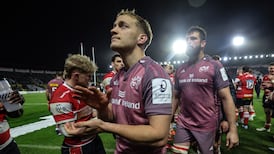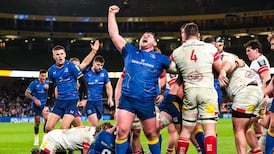I have some good news and some bad news.
Firstly, here is some good news for Ireland. Italy are terrible.
Conor O’Shea is a highly intelligent man of deep integrity and possesses an excellent rugby mind. You will not find a better man than Conor. However, the Italian players’ skills set will not allow him to be successful.
The Italians are on a long desert crossing. If they stop they will perish. They simply have to keep going, knowing a win will come along one day, but not on Sunday.
That’s all I could dig up on the “reasons to be cheerful” side of things.
Now for the bad news.
After each week of the Six Nations a group of highly trained Sports Performance Analysts pick through the bones of every Six Nations match, like a group of sporting forensic pathologists. They produce an independently compiled statical analysis document regarding all of the matches. This allows "anoraks" like me, to identify trends.
The numbers around the Irish attack after the first two rounds are not pretty.
Ireland lead the way with the highest percentage of possession at 56.6 per cent. So Ireland had plenty of ball. England only had 44.5 per cent of possession which surprisingly, is the lowest of the championship.
So what’s bad about that you ask?
It’s not about how long you have the ball, it’s all about where you have possession and what you do when you have it.
Ireland had the ball in opposition territory only 38.2 per cent of the game. That is the lowest in the Six Nations. So Ireland have had more ball than any team, but they have had it in their own half. Compare that to England, who have had possession the least, but have been in the opponents half for 62.5 per cent of the matches, which is the best on the Six Nations teams.
Brace yourself, it gets worse.
Ireland have made the most passes with 364 – 113 more passes than England’s 251. Ireland have also had the most rucks, with a whopping 276 rucks compared to England’s 178. What this means is that Ireland have been effectively tackled 276 times. Lots of passes to forwards standing still who get tackled. The term “breakdown” means just that, the attack has broken down.
Independent numbers
These are independent numbers, not opinions. I am not making this up.
At its essence rugby is a very simple game. You can only take the ball forward three ways. You can maul, kick or carry the ball forward. A team’s “go forwards” uses these three elements to advance towards your opponents’ try line.
If your team has possession and is not advancing, by definition and common sense, it has to be one of, or more likely a combination, of these elements.
Ireland are not going forward because firstly, the Irish forwards are receiving the ball standing still and getting tackled behind the gain line and Ireland’s curious tactic of their outhalves refusing to kick the ball when in their own half. These two problems compromise Ireland’s go forward.
Compare this to England's attack, where Owen Farrell kicks England into superb position, then the English forwards, running at full tilt before receiving the ball, get over the gain line and commence the "go forward" to create the space for the English backs to work in.
Eddie Jones and Gregor Townsend both knew Ireland would not kick for territory from their own half. So England and Scotland (and you can bet your “hard earned” that Italy will try to do the same,) compressed their defensive line. Meaning they stood closer together, so there was no space between defenders and they sprinted forward catching the Irish forwards waiting for the pass and not running onto the ball.
This rushing defence stops the Irish attack exploiting the space between and around the defenders.
However, in the “ying and yang” of attack versus defence, there is a balance. Where the defence takes space away in one area, it gives space in another.
A compressed, rushing defensive line shuts down the space in front of the ball carriers but it opens up “paddocks” of space behind it. This space is best exploited via the attacking kick.
Owen Farrell has done this brilliantly in the opening two rounds and England have been rewarded with the best territorial statistics in the opposition half with the least amount of possession. England have used their possession much more effectively than all the other teams.
Strong positions
Ireland’s outhalves, Sexton and Carberry are not kicking to attack the space behind the rushing defenders and Conor Murray’s box kicking has been uncharacteristically poor.
Italy could not have come at a better time for Ireland. The Italians will provide an opportunity for Ireland to get their attacking shape organised, align deeper and run with real purpose onto the ball.
Sexton, and Carty if he gets a run, must punt their team into strong positions and exploit the space behind the Italian defensive line. (Boys, if you are confused please call Ronan O’Gara. He did this magnificently for more than a decade.) To put it simply, Ireland must play the game in their opponents’ half.
In Rome, it is paramount for Ireland to come away with a bonus point win. They may also require a trip to the Vatican to pray for a miraculous Welsh performance, because by all the relevant numbers, England are a mile in front of the other five teams.











